NCERT Solutions for Class 7 Maths Chapter 2 Fractions and Decimals Exercise 2.1 - Free PDF Download
NCERT Solutions Class 7 Maths Chapter 2 Exercise 2.1 Solutions can be easily availed and be quickly downloaded from Vedantu in secure PDF format. The subject is complicated for the young minds and can often lead to confusion; hence, the provided Solutions for Class 7 Maths Ch 2 Ex 2.1. becomes very important to help when required a reference. The experts from Vedantu have utilized their years of teaching experience to help students in need in the format of PDF, which can be downloaded in simple steps from their website. You can also download NCERT Solutions for Class 7 Maths to help you to revise complete syllabus and score more marks in your examinations.
 Table of Content
Table of ContentGlance of NCERT Solutions for Class 7 Maths Chapter 2 Fractions and Decimals | Vedantu
Class 7 Maths Exercise 2.1 Solutions for Chapter 2 Fractions and Decimals likely cover concepts related to converting between fractions and decimals, performing addition and subtraction on them, and comparing their values.
Convert a fraction to a decimal by dividing the numerator (top number) by the denominator (bottom number). For instance, 1/2 = 0.5 (divide 1 by 2).
When fractions have the same denominator (like 1/2 + 1/2), you simply add or subtract the numerators and keep the denominator the same. If the fractions have different denominators, you should convert them to equivalent fractions with a common denominator before adding or subtracting.
Compare fractions with the same denominator by looking at their numerators. The larger numerator signifies a larger fraction. To compare a fraction with a decimal, you can convert the fraction to a decimal and then compare the two decimals.
Access NCERT Solutions for Class 7 Maths Chapter 2 Fractions and Decimals Exercise 2.1
1. Which of the drawings (a) to (d ) show:
(i) $2 \times \dfrac{1}{5} $
(ii) $2 \times \dfrac{1}{2} $
(iii) $3 \times \dfrac{2}{3}$
(iv) $3 \times \dfrac{1}{4}$
(a)

(b)
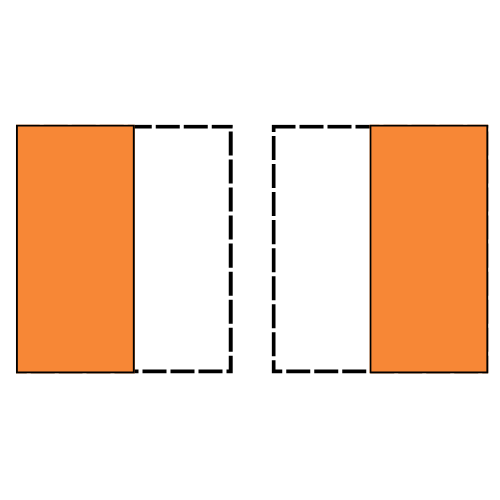
(c)
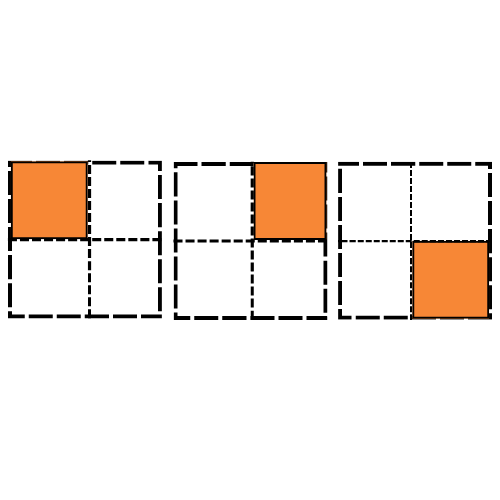
(d)

Ans:
(i) Given: $2 \times \dfrac{1}{5} $
We need to find which figure represent the above expression.
We can write it as
$2 \times \dfrac{1}{5} = \dfrac{1}{5} + \dfrac{1}{5}$
Fig(d) represents two figures in which each figure have\[1\] shaded part out of \[5\] equal parts .
So, we have $\dfrac{1}{5}$shaded part from both figures.
$ \Rightarrow \dfrac{1}{5} + \dfrac{1}{5} = 2 \times \dfrac{1}{5} $
Hence, Fig (d) represents $2 \times \dfrac{1}{5} $.
(ii) Given: $2 \times \dfrac{1}{2} $
We need to find which figure represent the above expression.
We can write it as
$2 \times \dfrac{1}{2} = \dfrac{1}{2} + \dfrac{1}{2}$
Fig(b) represents two figures in which each figure have 1 shaded part out of 2 equal parts.
So, we have $\dfrac{1}{2}$ shaded part from both figures.
$ \Rightarrow \dfrac{1}{2} + \dfrac{1}{2} = 2 \times \dfrac{1}{2}$
Hence, Fig(b) represents $2 \times \dfrac{1}{2}$.
(iii) Given: $3 \times \dfrac{2}{3}$
We need to find which figure represent the above expression.
We can write it as
$3 \times \dfrac{2}{3} = \dfrac{2}{3} + \dfrac{2}{3} + \dfrac{2}{3}$
Fig(a) represents three figures in which each figure have \[2\] shaded parts out of \[3\]equal parts .
So, we have $\dfrac{2}{3}$ shaded part from each figure.
$ \Rightarrow \dfrac{2}{3} + \dfrac{2}{3} + \dfrac{2}{3} = 3 \times \dfrac{2}{3}$
Hence, Fig (a) represents $3 \times \dfrac{2}{3}$.
(iv) Given: $3 \times \dfrac{1}{4}$
We need to find which figure represent the above expression.
We can write it as
$3 \times \dfrac{1}{4} = \dfrac{1}{4} + \dfrac{1}{4} + \dfrac{1}{4}$
Fig(c) represents three figures in which each figure have \[1\] shaded part out of \[4\] equal parts .
So, we have $\dfrac{1}{4}$ shaded part from each figure.
$ \Rightarrow \dfrac{1}{4} + \dfrac{1}{4} + \dfrac{1}{4} = 3 \times \dfrac{1}{4}$
Hence, Fig (c) represents $3 \times \dfrac{1}{4}$.
2. Some pictures (a) to (c) are given below. Tell which of them show:
(i)$3 \times \dfrac{1}{5} = \dfrac{3}{5}$ (ii) $2 \times \dfrac{1}{3} = \dfrac{2}{3}$ (iii) $3 \times \dfrac{3}{4} = 2\dfrac{1}{4}$
(a)

(b)
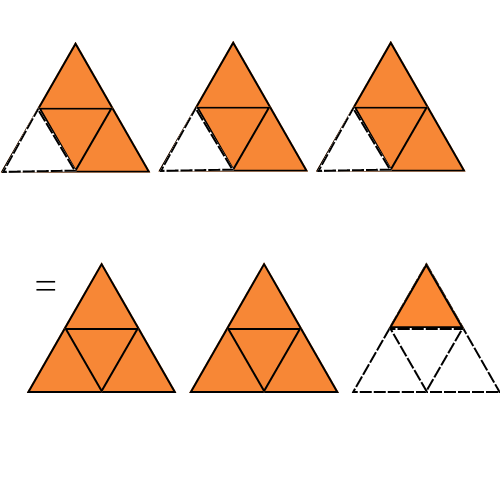
(c)
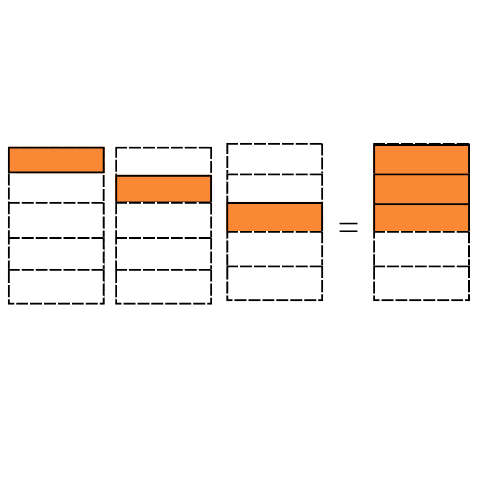
Ans: (i)Given: $3 \times \dfrac{1}{5} = \dfrac{3}{5} $
We need to find which figure represent the above expression.
We can write it as
$3 \times \dfrac{1}{5} = \dfrac{3}{5} = \dfrac{1}{5} + \dfrac{1}{5} + \dfrac{1}{5} $
Fig(c) represents three figures in which each figure have $1 $ shaded part out of $5 $ equal parts .
So, we have $\dfrac{1}{5}$ shaded part from each figure.
$ \Rightarrow \dfrac{1}{5} + \dfrac{1}{5} + \dfrac{1}{5} = 3 \times \dfrac{1}{5} = \dfrac{3}{5} $
Hence, Fig (c) represents $3 \times \dfrac{1}{5} = \dfrac{3}{5} $.
(ii) Given: $2 \times \dfrac{1}{3} = \dfrac{2}{3} $
We need to find which figure represent the above expression.
We can write it as
$2 \times \dfrac{1}{3} = \dfrac{2}{3} = \dfrac{1}{3} + \dfrac{1}{3} $
Fig(a) represents two figures in which each figure have 1 shaded part out of $3 $equal parts.
So, we have $\dfrac{1}{3} $ shaded part from both figures.
$ \Rightarrow \dfrac{1}{3} + \dfrac{1}{3} = 2 \times \dfrac{1}{3} = \dfrac{2}{3} $
Hence, Fig(a) represents $2 \times \dfrac{1}{3} = \dfrac{2}{3} $.
(iii) Given: $3 \times \dfrac{3}{4} = 2\dfrac{1}{4} $
We need to find which figure represent the above expression.
We can write it as
$ \Rightarrow 3 \times \dfrac{3}{4} = \dfrac{3}{4} + \dfrac{3}{4} + \dfrac{3}{4} $
Fig(b) represents three figures in which each figure have $3 $ shaded parts out of $4 $ equal parts .
So, we have $\dfrac{3}{4} $ shaded part from each figure.
$ \Rightarrow \dfrac{3}{4} + \dfrac{3}{4} + \dfrac{3}{4} = 3 \times \dfrac{3}{4} $
Hence, Fig (b) represents $3 \times \dfrac{3}{4} = 2\dfrac{1}{4} $.
3. Multiply and reduce to lowest form and convert into a mixed fraction:
(i) $7 \times \dfrac{3}{5} $
Ans: Given: $7 \times \dfrac{3}{5} $
We need to convert the given expression into a mixed fraction.
Multiplication of Fraction rule is given by
Product of fraction $ = $(product of numerator)/(product of denominator)
$\Rightarrow 7 \times \dfrac{3}{5} $
$= (\dfrac{7}{1}) \times (\dfrac{3}{5}) $
$ = \dfrac{7 \times 3}{5 \times 1}$
$= \dfrac{21}{5}$
$= 4\dfrac{1}{5} $ $ \text{(because multiplication of fraction rule)} $
(ii) $4 \times \dfrac{1}{3} $
Ans: Given: $4 \times \dfrac{1}{3} $
We need to convert given expression into mixed fraction.
Multiplication of Fraction rule is given by
Product of fraction $ = $(product of numerator)/(product of denominator)
$\Rightarrow 4 \times \dfrac{1}{3} $
$ = \dfrac{4 \times 1}{3} $
$= \dfrac{4}{3} $
$ = 1\dfrac{1}{3} $ $ \text{(because multiplication of fraction rule)} $
(iii) $2 \times \dfrac{6}{7} $
Ans: Given: $2 \times \dfrac{6}{7} $
We need to convert given expression into mixed fraction.
Multiplication of Fraction rule is given by
Product of fraction $ = $(product of numerator)/(product of denominator)
$\Rightarrow 2 \times \dfrac{6}{7} $
$ = \dfrac{{2 \times 6}}{7} $
$ = \dfrac{12}{7} $
$ = 1\dfrac{5}{7} $ $ \text{(because multiplication of fraction rule)} $
(iv) $5 \times \dfrac{2}{9} $
Ans: Given: $5 \times \dfrac{2}{9} $
We need to convert the given expression into a mixed fraction.
Multiplication of Fraction rule is given by
Product of fraction $ = $(product of numerator)/(product of denominator)
$\Rightarrow 5 \times \dfrac{2}{9} $
$ = \dfrac{5 \times 2}{9} $
$ = \dfrac{10}{9} $
$ = 1\dfrac{1}{9} $ $ \text{(because multiplication of fraction rule)} $
(v) $\dfrac{2}{3} \times 4$
Ans: Given: $\dfrac{2}{3} \times 4 $
We need to convert given expression into mixed fraction.
Multiplication of Fraction rule is given by
Product of fraction $ = $(product of numerator)/(product of denominator)
$ \Rightarrow \dfrac{2}{3} \times 4 $
$= \dfrac{{2 \times 4}}{3} $
$= \dfrac{8}{3} $
$ = 2\dfrac{2}{3} $ $ \text{(because multiplication of fraction rule)} $
(vi) $ \dfrac{5}{2} \times 6 $
Ans: Given: $5 \times \dfrac{2}{6} $
We need to convert the given expression into a mixed fraction.
Multiplication of Fraction rule is given by
Product of fraction $ = $(product of numerator)/(product of denominator)
$\Rightarrow \dfrac{5}{2} \times 6$
$= 5 \times 3 $
$ = 15 $ $ \text{(because multiplication of fraction rule)} $
(vii) $11 \times \dfrac{4}{7} $
Ans: Given: $11 \times \dfrac{4}{7} $
We need to convert given expression into mixed fraction.
Multiplication of Fraction rule is given by
Product of fraction $ = $(product of numerator)/(product of denominator)
$\Rightarrow 11 \times \dfrac{4}{7} $
$ = \dfrac{11 \times 4}{7} $
$= \dfrac{44}{7} $
$ = 6\dfrac{2}{7} $ $ \text{(because multiplication of fraction rule)} $
(viii) $20 \times \dfrac{4}{5} $
Ans: Given: $20 \times \dfrac{4}{5} $
We need to convert given expression into mixed fraction.
Multiplication of Fraction rule is given by
Product of fraction $ = $(product of numerator)/(product of denominator)
$\Rightarrow 20 \times \dfrac{4}{5} $
$= \dfrac{20 \times 4}{5} $
$ = 4 \times 4 $
$ = 16 $ $ \text{(because multiplication of fraction rule)} $
(ix) $13 \times \dfrac{1}{3} $
Ans: Given: $13 \times \dfrac{1}{3} $
We need to convert given expression into mixed fraction.
Multiplication of Fraction rule is given by
Product of fraction $ = $(product of numerator)/(product of denominator)
$\Rightarrow 13 \times \dfrac{1}{3} $
$ = \dfrac{13 \times 1}{3} $
$= \dfrac{13}{3}$
$ = 4\dfrac{1}{3} $ $ \text{(because multiplication of fraction rule)} $
(x) $15 \times \dfrac{3}{5} $
Ans: Given : $15 \times \dfrac{3}{5} $
We need to convert given expression into mixed fraction.
Multiplication of Fraction rule is given by
Product of fraction $ = $(product of numerator)/(product of denominator)
$\Rightarrow 15 \times \dfrac{3}{5}$
$ = \dfrac{{15 \times 3}}{5}$
$ = 3 \times 3$
$ = 9 $ $ \text{(because multiplication of fraction rule)} $
4. Shade:
(i) $\dfrac{1}{2}$
of the circles in box
(ii) $\dfrac{2}{3}$
of the triangles in box
(iii) $\dfrac{3}{5}$
of the squares in box
(a)
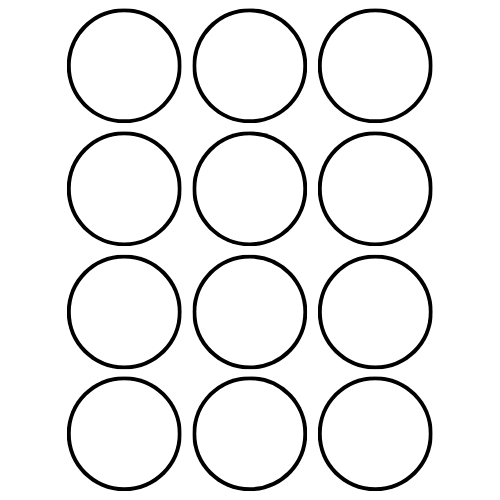
(b)
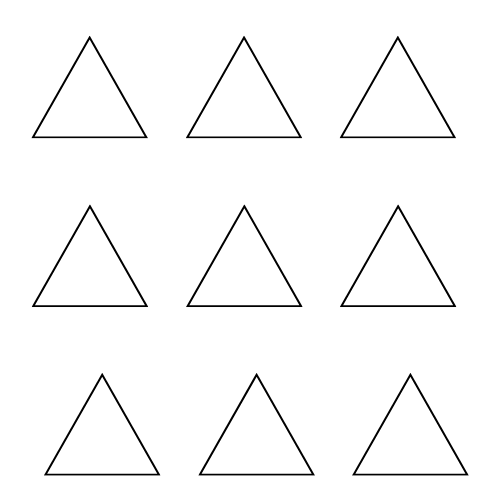
(c)
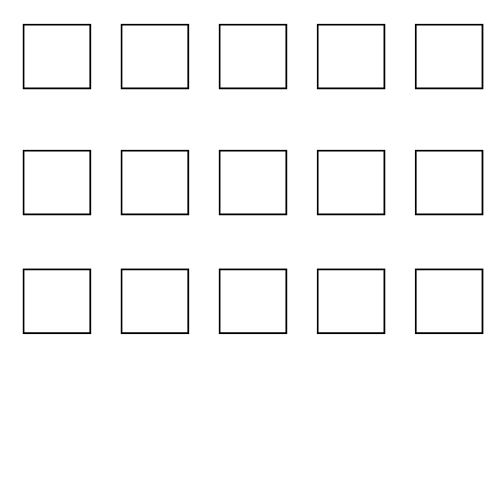
Ans:
(i) Given: \[12\] circles in the box.
We need to shade $\dfrac{1}{2}$of the circles in the box.
As we know , there are \[12\] circles in the box.
$ \Rightarrow \dfrac{1}{2}$ of the \[12\] circles
$= \dfrac{1}{2} \times 12 $
$= 6\,\,circles\,\, $
Hence, we have to shade any \[6\]circles in the box.
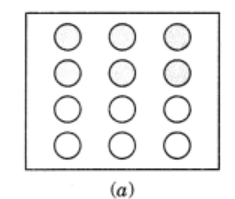
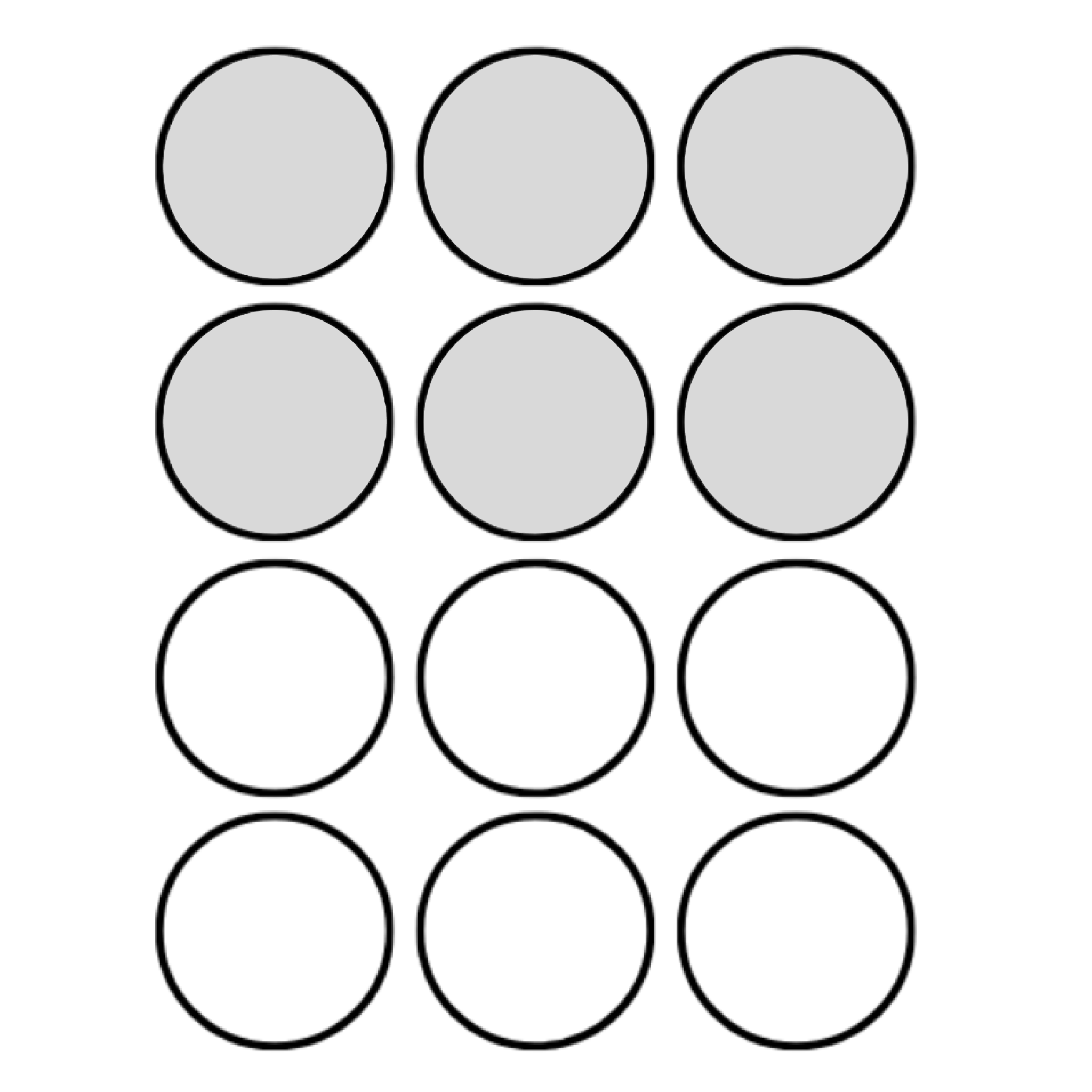
(ii) Given: \[9\] triangles in the box.
We need to shade $\dfrac{2}{3}\,$ of the triangles in the box.
As we know ,there are \[9\] triangles in the box.
$ \Rightarrow \dfrac{2}{3}\,\,of\,the\,\,9\,\,triangles $
$ = \dfrac{2}{3} \times 9 $
$ = 6\,\,triangles $
Hence, we have to shade any \[6\,\]triangles in the box.
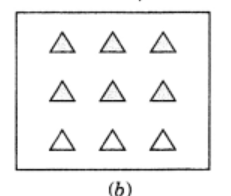
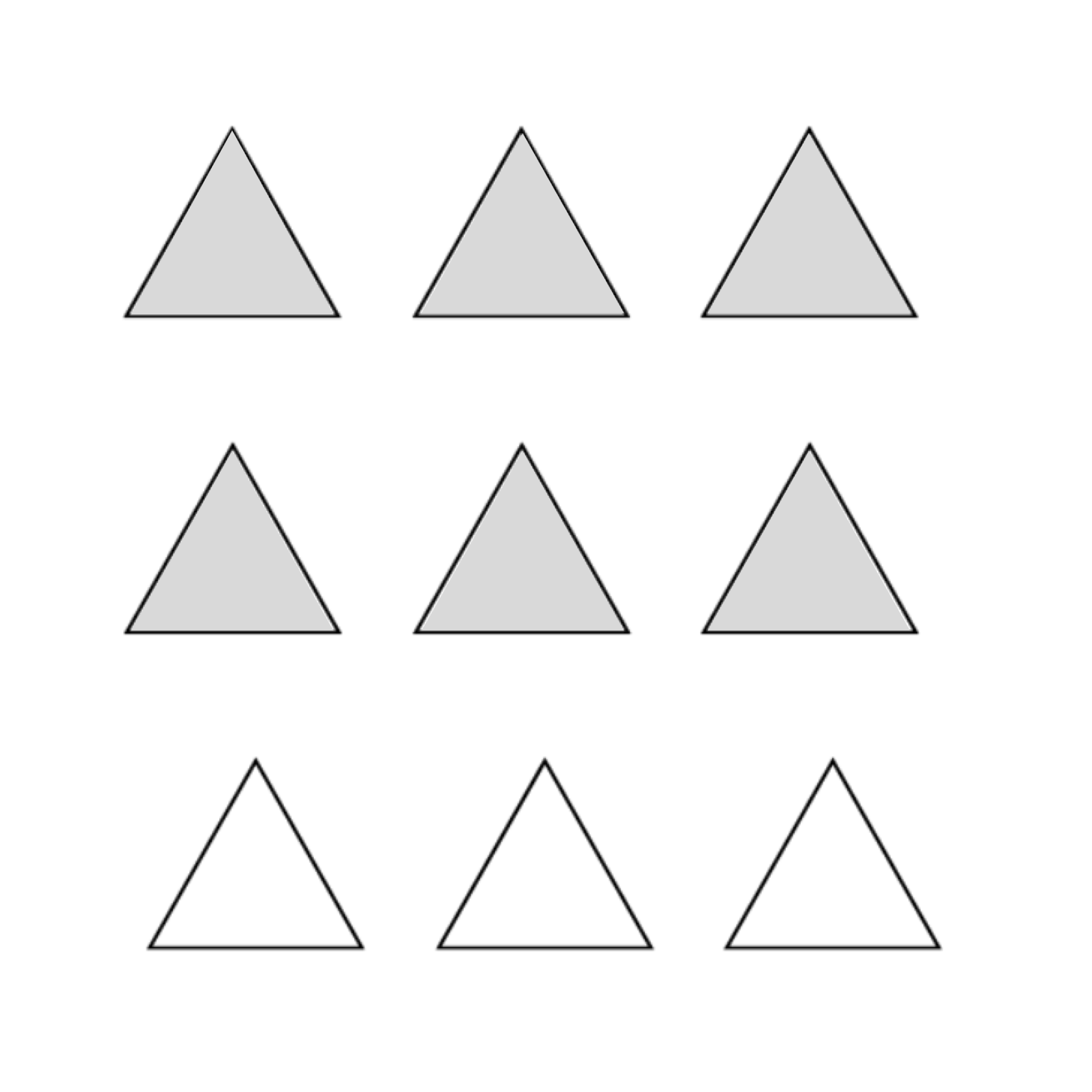
(iii) Given: \[15\] squares in the box.
We need to shade $\dfrac{3}{5}$ of the squares in the box.
As we know ,there are \[15\] squares in the box.
$ \Rightarrow \dfrac{3}{5}\,of\,the\,15\,\,squares $
$ = \dfrac{3}{5} \times 15 $
$= \dfrac{3 \times 15}{5} $
$ = 3 \times 3 $
$ = 9\,squares$
Hence, we have to shade any \[9\,\] squares in the box.
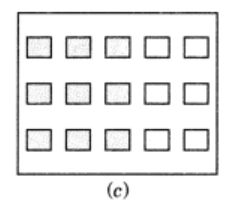
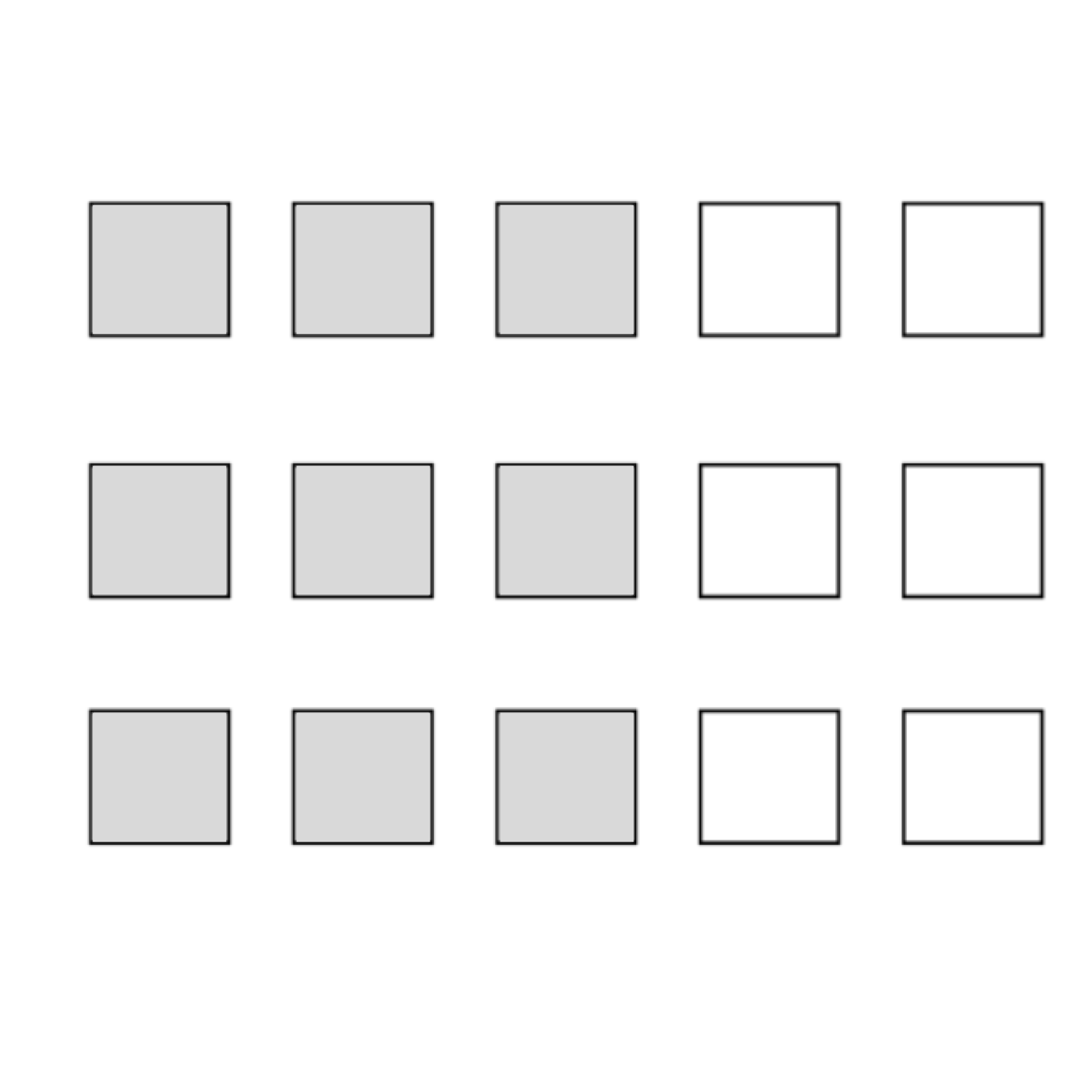
5. Find:
(a) $\dfrac{1}{2}\,\,$of (i) \[24\] (ii) \[46\]
Ans:
(i) \[24\]
We need to find $\dfrac{1}{2}\,$of \[24\].
Multiplying $\dfrac{1}{2}\,$by \[24\],we get
$= \dfrac{1}{2} \times 24 $
$ = 12$
(ii) \[46\]
We need to find $\dfrac{1}{2}\,\,$ of \[46\].
Multiplying $\dfrac{1}{2}\,$ by \[46\],we get
$ = \dfrac{1}{2} \times 46 $
$ = 23 $
(b) $\dfrac{2}{3}$ of (i) \[18\] (ii) \[27\]
Ans: (i) \[18\]
We need to find $\dfrac{2}{3}$ of \[18\].
Multiplying $\dfrac{2}{3}$by \[18\],we get
$ = \dfrac{2}{3} \times 18 $
$ = 2 \times 6 $
$ = 12 $
(ii) \[27\]
We need to find $\dfrac{2}{3}$of \[27\].
Multiplying $\dfrac{2}{3}$ by \[18\],we get
$ = \dfrac{2}{3} \times 27 $
$ = 2 \times 9 $
$ = 18 $
(c) $\dfrac{3}{4}$ of (i) \[16\] (ii) \[36\]
Ans:
(i) \[16\]
We need to find $\dfrac{3}{4}$ of \[16\].
Multiplying $\dfrac{3}{4}$ by \[16\],we get
$= \dfrac{3}{4} \times 16 $
$ = 3 \times 4 $
$ = 12 $
(ii) \[36\] We need to find $\dfrac{3}{4}$ of \[36\].
Multiplying $\dfrac{3}{4}$by \[36\],we get
$= \dfrac{3}{4} \times 36 $
$= 3 \times 9 $
$ = 27$
(d) $\dfrac{4}{5}$ of (i) \[20\] (ii) \[35\]
Ans:
(i) \[20\]
We need to find $\dfrac{4}{5}$ of \[20\].
Multiplying $\dfrac{4}{5}$ by \[20\],we get
$= \dfrac{4}{5} \times 20$
$= 4 \times 4 $
$= 16 $
(ii) \[35\]
We need to find $\dfrac{4}{5}$ of \[35\].
Multiplying $\dfrac{4}{5}$ by \[35\],we get
$ = \dfrac{4}{5} \times 35 $
$ = 4 \times 7 $
$= 28$
6. Multiply and express as a mixed fraction:
(a) \[3 \times 5\dfrac{1}{5}\]
Firstly we need to convert the given mixed fraction into improper fraction.
We take \[5\dfrac{1}{5}\] and multiply \[5\] by \[5\] and add \[1\],we get
\[ = (5 \times 5) + 1 = 26\]
Using \[26\] as numerator ,we get
\[5\dfrac{1}{5} = \dfrac{{26}}{5}\]
Now , \[3 \times 5\dfrac{1}{5}\]\[ = 3 \times \dfrac{{26}}{5}\]
$ = \dfrac{3 \times 26}{5} $
$ = \dfrac{78}{5} $
And convert it into mixed fraction ,firstly divide \[78\] by \[5\] and take remainder\[(3)\]as numerator and quotient\[(15)\] as whole number,we get
\[ = 15\dfrac{3}{5}\]
(b) \[5 \times 6\dfrac{3}{4}\]
Firstly we need to convert the given mixed fraction into improper fraction.
We take \[6\dfrac{3}{4}\] and multiply \[6\] by \[4\] and add \[3\],we get
\[ = (6 \times 4) + 3 = 27\]
Using \[27\] as numerator ,we get
\[6\dfrac{3}{4} = \dfrac{27}{4}\]
Now , \[5 \times 6\dfrac{3}{4} = 5 \times \dfrac{27}{4}\]
$= \dfrac{5 \times 27}{4} $
$ = \dfrac{135}{4}$
And convert it into mixed fraction ,firstly divide \[135\] by \[4\] and take remainder\[(3)\]as numerator and quotient \[(33)\] as whole number,we get
\[ = 33\dfrac{3}{4}\]
(c) \[7 \times 2\dfrac{1}{4}\]
Firstly we need to convert the given mixed fraction into improper fraction.
We take \[2\dfrac{1}{4}\] and multiply \[2\] by \[4\]and add \[1\],we get
\[ = (2 \times 4) + 1 = 9\]
Using \[9\]as numerator ,we get
\[2\dfrac{1}{4} = \dfrac{9}{4}\]
Now , \[7 \times 2\dfrac{1}{4} = 7 \times \dfrac{9}{4}\]
\[ = \dfrac{{63}}{4}\]
And convert it into mixed fraction ,firstly divide \[63\] by \[4\] and take remainder\[(3)\]as numerator and quotient \[(15)\] as whole number,we get
\[ = 15\dfrac{3}{4}\]
(d) \[4 \times 6\dfrac{1}{3}\]
Firstly we need to convert the given mixed fraction into improper fraction.
We take \[6\dfrac{1}{3}\] and multiply \[6\] by \[3\]and add \[1\],we get
\[ = (6 \times 3) + 1 = 19\]
Using \[19\] as numerator ,we get
\[6\dfrac{1}{3} = \dfrac{{19}}{3}\]
Now , \[4 \times 6\dfrac{1}{3} = 4 \times \dfrac{{19}}{3}\]
$ = \dfrac{4 \times 19}{3} $
$= \dfrac{76}{3} $
And convert it into mixed fraction ,firstly divide \[76\] by \[3\] and take remainder \[(1)\]as numerator and quotient \[(25)\] as whole number,we get
\[ = 25\dfrac{1}{3}\]
(e) \[3\dfrac{1}{4} \times 6\]
Firstly we need to convert the given mixed fraction into improper fraction.
We take \[3\dfrac{1}{4}\] and multiply \[3\] by \[4\]and add \[1\],we get
\[ = (3 \times 4) + 1 = 13\]
Using \[13\] as numerator ,we get
\[3\dfrac{1}{4} = \dfrac{{13}}{4}\]
Now , \[3\dfrac{1}{4} \times 6 = \dfrac{{13}}{4} \times 6\]
$ = \dfrac{13 \times 3}{2} $
$ = \dfrac{39}{2} $
And convert it into mixed fraction ,firstly divide \[39\] by \[2\] and take remainder \[(1)\]as numerator and quotient \[(19)\] as whole number,we get
\[ = 19\dfrac{1}{2}\]
(f) \[3\dfrac{2}{5} \times 8\]
Firstly we need to convert the given mixed fraction into improper fraction.
We take \[3\dfrac{2}{5}\] and multiply \[3\] by \[5\]and add \[2\],we get
\[ = (3 \times 5) + 2 = 17\]
Using \[17\] as numerator ,we get
\[3\dfrac{2}{5} = \dfrac{{17}}{5}\]
Now , \[3\dfrac{2}{5} \times 8 = \dfrac{{17}}{5} \times 8\]
$ = \dfrac{17 \times 8}{5} $
$= \dfrac{136}{5} $
And convert it into mixed fraction ,firstly divide \[27\] by \[5\] and take remainder \[(1)\]as numerator and quotient \[(27)\] as whole number,we get
\[ = 27\dfrac{1}{5}\]
7. Find:
(a) $\dfrac{1}{2}$ of (i) \[2\dfrac{3}{4}\] (ii) \[4\dfrac{2}{9}\]
Ans:
(i) \[2\dfrac{3}{4}\]
We need to find $\dfrac{1}{2}$ of \[2\dfrac{3}{4}\].
Firstly we need to convert the given mixed fraction into improper fraction.
We take \[2\dfrac{3}{4}\] and multiply \[2\] by \[4\]and add \[3\],we get
\[ = (2 \times 4) + 3 = 11\]
Using \[11\] as numerator ,we get
\[2\dfrac{3}{4} = \dfrac{{11}}{4}\]
Now, $\dfrac{1}{2} \times 2\dfrac{3}{4} = \dfrac{1}{2} \times \dfrac{{11}}{4}$
Using Multiplication of Fraction rule ,which is given by
Product of fraction \[ = \](product of numerator)/(product of denominator) ,we get
\[ = \dfrac{{11}}{8}\]
And convert it into mixed fraction ,firstly divide \[11\] by \[8\] and take remainder \[(3)\] as numerator and quotient \[(1)\] as whole number,we get
\[ = 1\dfrac{3}{8}\]
(ii) \[4\dfrac{2}{9}\]
We need to find $\dfrac{1}{2}$ of \[4\dfrac{2}{9}\].
Firstly we need to convert the given mixed fraction into improper fraction.
We take \[4\dfrac{2}{9}\] and multiply \[4\] by \[9\] and add \[2\],we get
\[ = (4 \times 9) + 2 = 38\]
Using \[38\] as numerator ,we get
\[4\dfrac{2}{9} = \dfrac{{38}}{9}\]
Now, $\dfrac{1}{2} \times 4\dfrac{2}{9} = \dfrac{1}{2} \times \dfrac{38}{9}$
Using Multiplication of Fraction rule which is given by
Product of fraction \[ = \](product of numerator)/(product of denominator),we get
\[ = \dfrac{{19}}{9}\]
And convert it into mixed fraction ,firstly divide \[19\] by \[9\] and take remainder \[(1)\] as numerator and quotient \[(2)\] as whole number,we get
\[ = 2\dfrac{1}{9}\]
(b) $\dfrac{5}{8}$ of (i) \[3\dfrac{5}{6}\] (ii) \[9\dfrac{2}{3}\]
Ans:
(i) \[3\dfrac{5}{6}\]
We need to find $\dfrac{5}{8}$ of \[3\dfrac{5}{6}\].
Firstly we need to convert the given mixed fraction into improper fraction.
We take \[3\dfrac{5}{6}\] and multiply \[3\] by \[6\] and add \[5\],we get
\[ = (3 \times 6) + 5 = 23\]
Using \[23\] as numerator ,we get
\[3\dfrac{5}{6} = \dfrac{{23}}{6}\]
Now, $\dfrac{5}{8} \times 3\dfrac{5}{6} = \dfrac{5}{8} \times \dfrac{{23}}{6}$
Using Multiplication of Fraction rule which is given by
Product of fraction \[ = \](product of numerator)/(product of denominator),we get
\[ = \dfrac{{115}}{{48}}\]
And convert it into mixed fraction ,firstly divide \[115\] by \[48\] and take remainder \[(19)\] as numerator and quotient \[(2)\] as whole number,we get
\[ = 2\dfrac{{19}}{{48}}\]
(ii) \[9\dfrac{2}{3}\]
We need to find $\dfrac{5}{8}$ of \[9\dfrac{2}{3}\].
Firstly we need to convert the given mixed fraction into improper fraction.
We take \[9\dfrac{2}{3}\] and multiply \[9\] by \[3\] and add \[2\],we get
\[ = (9 \times 3) + 2 = 29\]
Using \[29\] as numerator ,we get
\[9\dfrac{2}{3} = \dfrac{{29}}{3}\]
Now, $\dfrac{5}{8} \times 9\dfrac{2}{3} = \dfrac{5}{8} \times \dfrac{{29}}{3}$
Using Multiplication of Fraction rule which is given by
Product of fraction \[ = \](product of numerator)/(product of denominator),we get
\[ = \dfrac{{145}}{{24}}\]
And convert it into mixed fraction ,firstly divide \[145\] by \[24\] and take remainder \[(1)\] as numerator and quotient \[(6)\] as whole number,we get
\[ = 6\dfrac{1}{{24}}\]
8. Vidya and Pratap went for a picnic. Their mother gave them a water bottle that contained 5 litres of water. Vidya consumed $\dfrac{2}{5}$of the water. Pratap consumed the remaining water.
(i) How much water did Vidya drink?
(ii) What fraction of the total quantity of water did Pratap drink?
Ans:
Given: Total quantity of water in bottle = \[5\] litres
(i) We know, Vidya consumed = $\dfrac{2}{5}$ of \[5\] litres
$ \Rightarrow \dfrac{2}{5} \times 5 $
$ = 2 $
Therefore, Vidya drank 2 litres of water from the bottle.
(ii) We know , Pratap consumed the remaining fraction of water .
So, Pratap consumed \[ = (1 - \dfrac{2}{5})\] part of bottle
\[ = \dfrac{{5 - 2}}{3}\]
\[ = \dfrac{3}{5}\] part of bottle
Pratap consumed $\dfrac{3}{5}$ of \[5\] litres water \[ = \dfrac{3}{5} \times 5\]
\[ = 3\] litres
Therefore, Pratap drank $\dfrac{3}{5}$ part of the total quantity of water.
Conclusion
NCERT Solutions of Class 7th Maths Chapter 2 Exercise 2.1 Fractions and Decimals act as your guide, helping you understand different types of fractions, perform operations on them, and conquer decimals. Mastering these concepts with practice using the solutions strengthens your math foundation and prepares you for future challenges.
NCERT Solution Class 7 Maths Chapter 2 - Fractions and Decimals Other Exercises
Exercises | Number of Questions |
8 Questions & Solutions | |
4 Questions & Solutions | |
5 Questions & Solutions | |
6 Questions & Solutions |
CBSE Class 7 Maths Chapter 2 Other Study Materials
S. No | Important Links for Chapter 2 Fractions and Decimals |
1 | |
2 | |
3 | |
4 |
Chapter-Specific NCERT Solutions for Class 7 Maths
Given below are the chapter-wise NCERT Solutions for Class 7 Maths. Go through these chapter-wise solutions to be thoroughly familiar with the concepts.
S.No. | NCERT Solutions Class 7 Chapter-wise Maths PDF |
1. | |
2. | |
3. | |
4. | |
5. | |
6. | |
7. | |
8. | |
9. | |
10. | |
11. | |
12. | |
13. |
Important Related Links for NCERT Class 7 Maths
Access these essential links for NCERT Class 7 Maths, offering comprehensive solutions, study guides, and additional resources to help students master language concepts and excel in their exams.
S.No | Other CBSE Study Materials for Class 7 Maths |
1 | |
2 | |
3 | |
4 | |
5 | |
6. | |
7. | |
8. | |
9. |
FAQs on NCERT Solutions for Class 7 Maths Chapter 2 Fractions And Decimals Ex 2.1
1. What topics are covered in NCERT Class 7 Maths Ex 2.1 Chapter 2?
Class 7th Maths Exercise 2.1 focuses on the addition and subtraction of fractions. It includes problems where students need to add and subtract fractions with like and unlike denominators.






















